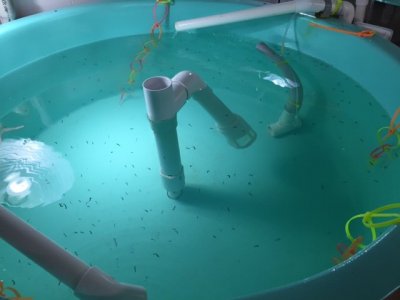Using the pump was smart. I would probably give them more time to feed but since you succeeded, you have to do what works for you.
I like encourage everyone to try to raise the fry. It is very educational and really gives you an appreciation of what it takes. Success is not based on your overall experience in the hobby but rather what learn from research and experience with this particular area. I have seen newbies succeed, often more than the old pro's who decide to try seahorses. Plus, succeeding in raising even one is an accomplishment that many, if not most, don't have. Patience, persistence, some study and a lot of work is what it takes.
The reason I am anti-kreisel is:
12 - 13 years ago, I tried it. It didn't seem natural to me from the start. I have spent most of my life near the ocean and a lot of time on the water. I could not see how they would have this action in their natural environment.
The reason that most folks use a kreisel is to keep the fry from the surface for fear of them getting air bubbles. The rotating action of the kreisel is designed for pelagic species such as jellyfish to keep them in suspension. The first issue I have with this for seahorses is that nature has programed the fry to go towards the surface to feed on zooplankton. So that is what they are going to try to do. The action of a properly setup kreisel prevents this or keeps moving them away from the surface. The fry will continue to go up. This results in them expending a lot more energy. I prefer for that energy to used for growth and development instead of wearing them out. By going to a horizontal type flow such as in a round tub, the fry will line up facing the current wherever the light is and just hover and feed. This is pretty much what they would do in the wild. Less energy wasted, faster growth and it doesn't wear or stress them out.
The air bubble issue is not from them ingesting air. I agree with Wolfgang Mai who several years ago wrote that the bubbles that fry get are from a bacterial issue developing in the GI Tract. By reducing the bacterial loads in our live foods, we were able to totally eliminate fry with air bubbles. Even our pelagic fry such as reidi, kuda, ingens, etc are allow to feed near the top of the water.
There is a another reason fry can get caught on the water surface. This is from the surface tension of the atmosphere and the water and sometimes along the meniscus where the water surface and tank meet. By having some surface agitation with incoming water and airlines, this is easily handled. Within a couple of days the fry become strong enough for this not to be an issue anyway.
The second reason against kreisels is the overall design of what most use. A true kreisel is designed with a solid filtration scheme. A commercial kreisel will have a steady inflow of water and export of old water. The water exiting will normally be on the outside edge where there is better water change as opposed to the middle of the side. They are also much larger and more stable not to mention, very expensive. Most of the small goldfish bowl style homemade psuedo kreisels don't have enough water volume for the amount of fry and have poor water exchange. Besides not being a natural type environment for the fry, there is now the issue of limited surface area for gas exchange and build up of organics. This can quickly lead to low O2 saturation, poor ORP and an explosion of microbial growth. In short, more things to overcome in an already challenging attempt to rear the little creatures.
Your success, probably among other things, can be attributed to keeping a small amount and adding in more water to flush the tank. Hats off for the success!!!
Dan




